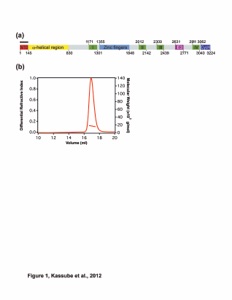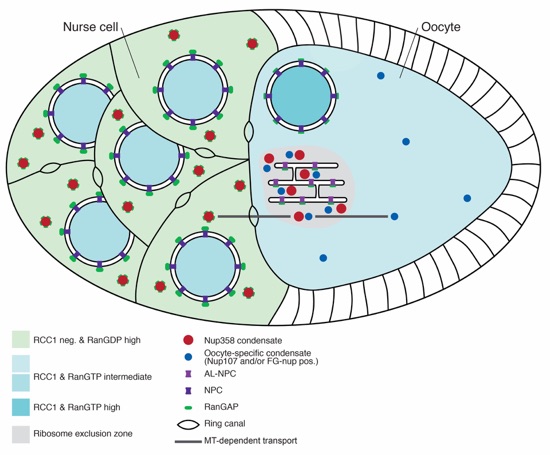Hoelz Lab: Publications
Figure 1. Distinct nucleoporin condensates mediate AL-NPC assembly during oogenesis. Schematic representation of a Drosophila melanogaster mid-stage egg chamber. During embryogenesis the oocyte is nourished by nurse cells, which supply both proteins and RNA through connective ring canals. Nup358 containing condensates form in the nurse cell, where high levels of RanGDP are maintained by the Ran GTPase-activating protein RanGAP located on both the cytoplasmic face of the NPC and within cytosolic Nup358 granules. In the oocyte, upregulation of the Ran guanine nucleotide exchange factor RCC1 leads to a cytoplasmic reservoir, elevating local RanGTP levels, which favors formation of different nup granules containing scaffold and/or FG-nups. Motor-dependent transport of both Nup358- and oocyte-specific granules along microtubules drives contact between these nup condensates at ribosome exclusion zones in the ooplasm, where the granule components are assembled into AL-NPCs on membrane sheets called annulate lamellae for storage. Upon fertilization membrane sheets containing multiple AL-NPC are then inserted into the NE.

Figures from the paper:
Abstract:
Oocytes stockpile nuclear pore complexes (NPCs) in cytoplasmic membrane sheets called annulate lamellae (AL) in preparation for rapid cell cycles during embryogenesis. Recently, Hampoelz et al. reported that AL-NPC assembly depends on the coordinated formation, transport, and interaction of biomolecular condensates containing distinct sets of nucleoporins.
Nucleoporin Condensates Drive Nuclear Pore Complex Assembly in Oocytes


California Institute of Technology
Division of Chemistry & Chemical Engineering
1200 E. California Blvd.
Pasadena, CA 91125-7200
© Copyright Hoelz Laboratory
Mobbs, G.W., Hoelz, A.* (2020). Trends Biochem Sci. 45 (4), 278-280

